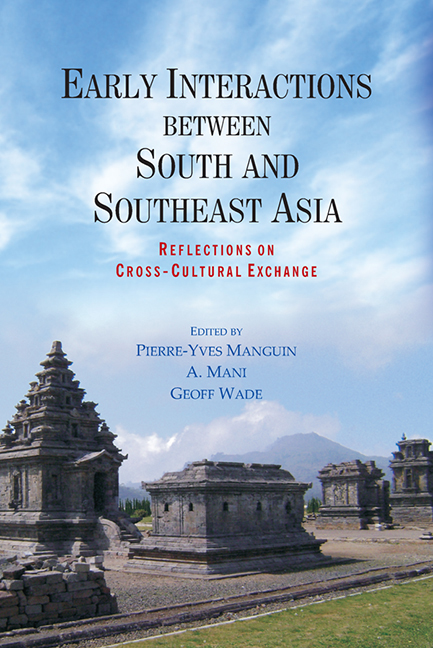Book contents
- Frontmatter
- Contents
- FOREWORD
- Preface
- Introduction
- PART I New Archaeological Evidence from South Asia and Southeast Asia
- 1 Central Vietnam during the Period from 500 BCE to CE 500
- 2 Ban Don Ta Phet and Khao Sam Kaeo: The Earliest Indian Contacts Re-assessed
- 3 Preliminary Study of Indian and Indian Style Wares from Khao Sam Kaeo (Chumphon, Peninsular Thailand), Fourth-Second Centuries BCE
- 4 Early Contacts between India and the Andaman Coast in Thailand from the Second Century BCE to Eleventh Century CE
- 5 The Batujaya Site: New Evidence of Early Indian Infl uence in West Java
- 6 Continuity and Change in South Indian Involvement in Northern Sumatra: The Inferences of Archaeological Evidence from Kota Cina and Lamreh
- 7 South Asia and the Tapanuli Area (North-West Sumatra): Ninth-Fourteenth Centuries CE
- 8 Emergence of Early Historic Trade in Peninsular India
- 9 Contacts between India and Southeast Asia in Ceramic and Boat Building Traditions
- 10 Marine Archaeological Investigations along the Tamil Nadu Coast and their Implications for Understanding Cultural Expansion to Southeast Asian Countries
- PART II Localisation in Southeast Asia
- LIST OF CONTRIBUTORS
- INDEX
1 - Central Vietnam during the Period from 500 BCE to CE 500
from PART I - New Archaeological Evidence from South Asia and Southeast Asia
Published online by Cambridge University Press: 21 October 2015
- Frontmatter
- Contents
- FOREWORD
- Preface
- Introduction
- PART I New Archaeological Evidence from South Asia and Southeast Asia
- 1 Central Vietnam during the Period from 500 BCE to CE 500
- 2 Ban Don Ta Phet and Khao Sam Kaeo: The Earliest Indian Contacts Re-assessed
- 3 Preliminary Study of Indian and Indian Style Wares from Khao Sam Kaeo (Chumphon, Peninsular Thailand), Fourth-Second Centuries BCE
- 4 Early Contacts between India and the Andaman Coast in Thailand from the Second Century BCE to Eleventh Century CE
- 5 The Batujaya Site: New Evidence of Early Indian Infl uence in West Java
- 6 Continuity and Change in South Indian Involvement in Northern Sumatra: The Inferences of Archaeological Evidence from Kota Cina and Lamreh
- 7 South Asia and the Tapanuli Area (North-West Sumatra): Ninth-Fourteenth Centuries CE
- 8 Emergence of Early Historic Trade in Peninsular India
- 9 Contacts between India and Southeast Asia in Ceramic and Boat Building Traditions
- 10 Marine Archaeological Investigations along the Tamil Nadu Coast and their Implications for Understanding Cultural Expansion to Southeast Asian Countries
- PART II Localisation in Southeast Asia
- LIST OF CONTRIBUTORS
- INDEX
Summary
INTRODUCTION
The time from 500 BCE to CE 500 (the protohistoric and early historic periods) is defined by scholars as the critical period in the cultural and historical process of Central Vietnam in particular and in Southeast Asia in general. According to scholars, this early historic period in mainland Southeast Asia straddled two critical junctures. The mid-first millennium BCE marks the transition to an ‘Iron Age’ and all the shifts that accompanied such a technological change. A second transition occurred in the later centuries BCE with the shift to the early historic period; changes during this time set the stage for the emergence of the region's first centralised polities (Stark and Bong Sovath 2001: 85).
Recent archaeological finds and discoveries lead us to recognise the dynamic cultural contacts of the area with the external world and strong acculturation between the exogenous and indigenous factors which led to formation of various kinds of early states. Due to these qualitative and critical changes, a big number of local cultural features disappeared, while the forms and behavioural patterns of the new cultural structure appeared to replace the old elements.
The main issues of this chapter are to provide:
• An overview on the archaeological cultures in Central Vietnam during the period from 500 BCE to CE 500.
• The transition processes from Sa Huynh to Champa reflected in thearchaeological sites and artefacts, and the discussion for the delimitation of the early historic period from 500 BCE to CE 500.
• Some opinions about the so-called Sinicisation, Indianisation and the impact of indigenous elements.
AN OVERVIEW OF THE ARCHAEOLOGICAL CULTURES IN CENTRAL VIETNAM, 500 BCE-CE 500
The Archaeological Sequences for Central Vietnam
According to Vietnamese archaeologists, archaeological sequences and chronologies for Central Vietnam could be reconstructed as follows:
Pre-Sa Huynh (or Early Sa Huynh, Initial Sa Huynh): It consists of some groups of sites (under the umbrella of Xom Con, Long Thanh, Binh Chau cultures). These cultures belong to the Early Metal Age from 3500 to 2600/2500 bp; all influenced each other and finally crystallised in one cultural tradition, which was represented by the Sa Huynh culture.
- Type
- Chapter
- Information
- Early Interactions between South and Southeast AsiaReflections on Cross-Cultural Exchange, pp. 3 - 16Publisher: ISEAS–Yusof Ishak InstitutePrint publication year: 2011



